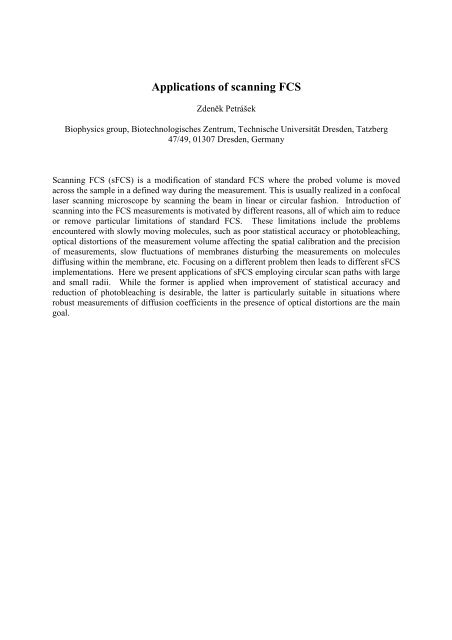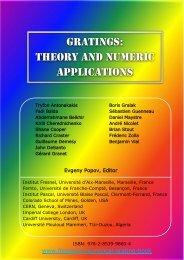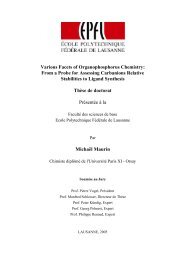12th Carl Zeiss sponsored workshop on ... - Institut Fresnel
12th Carl Zeiss sponsored workshop on ... - Institut Fresnel
12th Carl Zeiss sponsored workshop on ... - Institut Fresnel
Create successful ePaper yourself
Turn your PDF publications into a flip-book with our unique Google optimized e-Paper software.
Applicati<strong>on</strong>s of scanning FCS<br />
Zdeněk Petrášek<br />
Biophysics group, Biotechnologisches Zentrum, Technische Universität Dresden, Tatzberg<br />
47/49, 01307 Dresden, Germany<br />
Scanning FCS (sFCS) is a modificati<strong>on</strong> of standard FCS where the probed volume is moved<br />
across the sample in a defined way during the measurement. This is usually realized in a c<strong>on</strong>focal<br />
laser scanning microscope by scanning the beam in linear or circular fashi<strong>on</strong>. Introducti<strong>on</strong> of<br />
scanning into the FCS measurements is motivated by different reas<strong>on</strong>s, all of which aim to reduce<br />
or remove particular limitati<strong>on</strong>s of standard FCS. These limitati<strong>on</strong>s include the problems<br />
encountered with slowly moving molecules, such as poor statistical accuracy or photobleaching,<br />
optical distorti<strong>on</strong>s of the measurement volume affecting the spatial calibrati<strong>on</strong> and the precisi<strong>on</strong><br />
of measurements, slow fluctuati<strong>on</strong>s of membranes disturbing the measurements <strong>on</strong> molecules<br />
diffusing within the membrane, etc. Focusing <strong>on</strong> a different problem then leads to different sFCS<br />
implementati<strong>on</strong>s. Here we present applicati<strong>on</strong>s of sFCS employing circular scan paths with large<br />
and small radii. While the former is applied when improvement of statistical accuracy and<br />
reducti<strong>on</strong> of photobleaching is desirable, the latter is particularly suitable in situati<strong>on</strong>s where<br />
robust measurements of diffusi<strong>on</strong> coefficients in the presence of optical distorti<strong>on</strong>s are the main<br />
goal.













